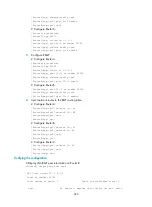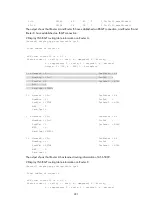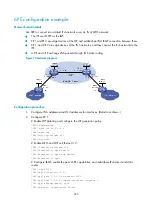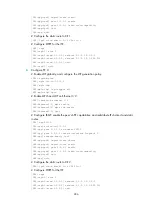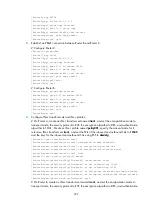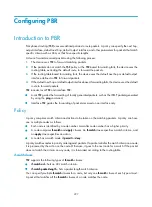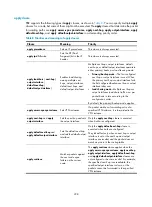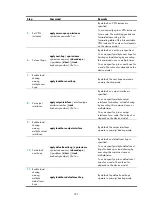
290
Connect Type: Indirect Running Up for: 00:00:05
Hold Time: 2243ms Auth mode: None
Detect Mode: Async Slot: 0
Protocol: BGP6
Diag Info: No Diagnostic
The output shows that a BFD session has been established between Router A and Router C.
# Display BGP peer information on Router C.
<RouterC> display bgp peer ipv6
BGP local router ID: 3.3.3.3
Local AS number: 200
Total number of peers: 2 Peers in established state: 2
Peer AS MsgRcvd MsgSent OutQ PrefRcv Up/Down State
2001::1 200 8 8 0 0 00:04:45 Established
3001::1 200 5 4 0 0 00:01:53 Established
The output shows that Router C has established two BGP connections with Router A, and both
connections are in Established state.
# Display route 1200::0/64 on Router C.
<RouterC> display ipv6 routing-table 1200::0 64 verbose
Summary Count : 1
Destination: 1200::/64
Protocol: BGP4+ Process ID: 0
SubProtID: 0x1 Age: 00h01m07s
Cost: 50 Preference: 255
Tag: 0 State: Active Adv
OrigTblID: 0x1 OrigVrf: default-vrf
TableID: 0xa OrigAs: 0
NBRID: 0x25000001 LastAs: 0
AttrID: 0x1 Neighbor: 3001::1
Flags: 0x10060 OrigNextHop: 3001::1
Label: NULL RealNextHop: FE80::20C:29FF:FE4A:3873
BkLabel: NULL BkNextHop: N/A
Tunnel ID: Invalid Interface: Ethernet1/1
BkTunnel ID: Invalid BkInterface: N/A
The output shows that Router C communicates with network 1200::0/64 through the path Router
C<—>Router B<—>Router A.
# Break down the path Router C<—>Router B<—>Router A and then display route 1200::0/64 on
Router C.
<RouterC> display ipv6 routing-table 1200::0 64 verbose
Summary Count : 1





